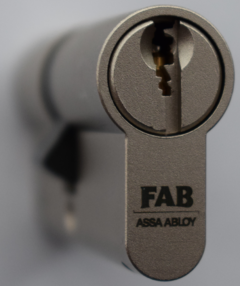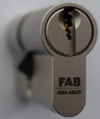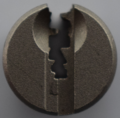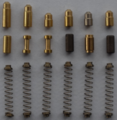FAB 3***/4****: Difference between revisions
(Added FAB 3*** Profi/4**** page.) |
mNo edit summary |
||
| (2 intermediate revisions by 2 users not shown) | |||
| Line 4: | Line 4: | ||
| name = FAB 3*** Profi/4**** | | name = FAB 3*** Profi/4**** | ||
| Img = File:FAB4xxxx_least.png | | Img = File:FAB4xxxx_least.png | ||
| maker = [[Fab]] | | maker = [[Fab|FAB]] | ||
| lock_type = [[Cylinder]] | | lock_type = [[Cylinder]] | ||
| lock_design = [[Pin_tumbler|Pin-tumbler]] | | lock_design = [[Pin_tumbler|Pin-tumbler]] | ||
| Line 15: | Line 15: | ||
}} | }} | ||
'''FAB 3*** Profi''' and '''FAB 4****''' are two | '''FAB 3*** Profi''' and '''FAB 4****''' are two [[pin-tumbler]] locks from [[Fab|FAB]]. FAB 3*** Profi belongs to a resistance class 3, FAB 4**** belongs to resistance class 4. These locks differ significantly from previous FAB products; both are six pin locks but they have new designs for key shoulder, shoulder stop, pins, cam clutch, and other components. | ||
__TOC__ | __TOC__ | ||
<br clear="all"> | <br clear="all"> | ||
== | == Principles of operation == | ||
:''See also: [[Pin-tumbler#Principles_of_Operation|Pin-Tumbler (Principles of Operation)]]'' | |||
Pinning "structure" is also different compared to older | Both locks are similar, but the FAB 4**** uses a different keyway, contains six more anti-drilling inserts, and by default contains a cam clutch allowing unlocking even when a key is inserted from the other side. | ||
Both locks have six pin chambers, equipped with a new style pins - both key pins and drivers are thinner than in previous generations of FAB locks. Key pins have even slimmer tops. Driver pins are different than previous iterations from FAB and the thinner spools don't cause as much counter-rotation when a false set is achieved, adding to the improved picking resistance. The springs used in these models are stronger than in prior FAB models. | |||
Pinning "structure" is also different compared to older FAB models - there is only one RBC pin, two spools and the rest are standard drivers (one brass, two steel ones in the back). The standard driver pin behavior is similar to the old beveled/tapered ones FAB used long time ago, which combined with the spools and the RBC pin improves the picking resistance further. | |||
Key is also very different, and it contains interesting feature (patented) - the key shoulder has a shape that interfaces with a groove in the core. This shape can be used for master-keying purposes, as detailed in the EP3219882B1 patent. | Key is also very different, and it contains interesting feature (patented) - the key shoulder has a shape that interfaces with a groove in the core. This shape can be used for master-keying purposes, as detailed in the EP3219882B1 patent. | ||
The core clutch used in FAB 3*** Profi is completely different - it has no moveable parts and uses a groove milled in the back of the core to function. | |||
== Disassembly instructions == | |||
The core has two groves for the cam clutch at 3 and 9'o clock positions, that would allow driver to jump out before the follower would hold it. The anti-drill insert chambers of 4**** are wide enough to catch a driver, so a core rotation of more than approximately 100 degrees to either side should be safe. Pinning shoe can be handy, although you have to count with the stronger springs and smaller pin diameter. Segmented follower can be used for the double euro format too. | |||
== Vulnerabilities == | == Vulnerabilities == | ||
| Line 39: | Line 41: | ||
* [[Lockpicking]] | * [[Lockpicking]] | ||
* [[Decoding]] | * [[Decoding]] | ||
* [[Key bumping]] - when | * [[Key bumping]] - when RBC pin is worked around | ||
* [[Impressioning]] | * [[Impressioning]] | ||
| Line 69: | Line 71: | ||
== See also == | == See also == | ||
* [[Fab]] | * [[Fab|FAB]] | ||
* [https://www.fab.cz/cs/site/fabcz/produkty/cylindricke-vlozky/fab-3-profi/ FAB 3*** Profi product page] | * [https://www.fab.cz/cs/site/fabcz/produkty/cylindricke-vlozky/fab-3-profi/ FAB 3*** Profi product page] | ||
* [https://www.fab.cz/cs/site/fabcz/produkty/cylindricke-vlozky/fab-4/ FAB 4**** product page] | * [https://www.fab.cz/cs/site/fabcz/produkty/cylindricke-vlozky/fab-4/ FAB 4**** product page] | ||
Latest revision as of 21:19, 24 March 2022
FAB 3*** Profi and 4****
| FAB 3*** Profi/4**** | |
 | |
| Name | FAB 3*** Profi/4**** |
|---|---|
| Manufacturer | FAB |
| Lock Type | Cylinder |
| Lock Design | Pin-tumbler |
| Year(s) Produced | 2021 - |
| Patent | EP3219882B1, EP3306017B1 |
FAB 3*** Profi and FAB 4**** are two pin-tumbler locks from FAB. FAB 3*** Profi belongs to a resistance class 3, FAB 4**** belongs to resistance class 4. These locks differ significantly from previous FAB products; both are six pin locks but they have new designs for key shoulder, shoulder stop, pins, cam clutch, and other components.
Principles of operation
- See also: Pin-Tumbler (Principles of Operation)
Both locks are similar, but the FAB 4**** uses a different keyway, contains six more anti-drilling inserts, and by default contains a cam clutch allowing unlocking even when a key is inserted from the other side. Both locks have six pin chambers, equipped with a new style pins - both key pins and drivers are thinner than in previous generations of FAB locks. Key pins have even slimmer tops. Driver pins are different than previous iterations from FAB and the thinner spools don't cause as much counter-rotation when a false set is achieved, adding to the improved picking resistance. The springs used in these models are stronger than in prior FAB models.
Pinning "structure" is also different compared to older FAB models - there is only one RBC pin, two spools and the rest are standard drivers (one brass, two steel ones in the back). The standard driver pin behavior is similar to the old beveled/tapered ones FAB used long time ago, which combined with the spools and the RBC pin improves the picking resistance further.
Key is also very different, and it contains interesting feature (patented) - the key shoulder has a shape that interfaces with a groove in the core. This shape can be used for master-keying purposes, as detailed in the EP3219882B1 patent.
The core clutch used in FAB 3*** Profi is completely different - it has no moveable parts and uses a groove milled in the back of the core to function.
Disassembly instructions
The core has two groves for the cam clutch at 3 and 9'o clock positions, that would allow driver to jump out before the follower would hold it. The anti-drill insert chambers of 4**** are wide enough to catch a driver, so a core rotation of more than approximately 100 degrees to either side should be safe. Pinning shoe can be handy, although you have to count with the stronger springs and smaller pin diameter. Segmented follower can be used for the double euro format too.
Vulnerabilities
The FAB 3*** Profi/4**** are vulnerable to one or more of the following:
- Lockpicking
- Decoding
- Key bumping - when RBC pin is worked around
- Impressioning
Gallery
References












